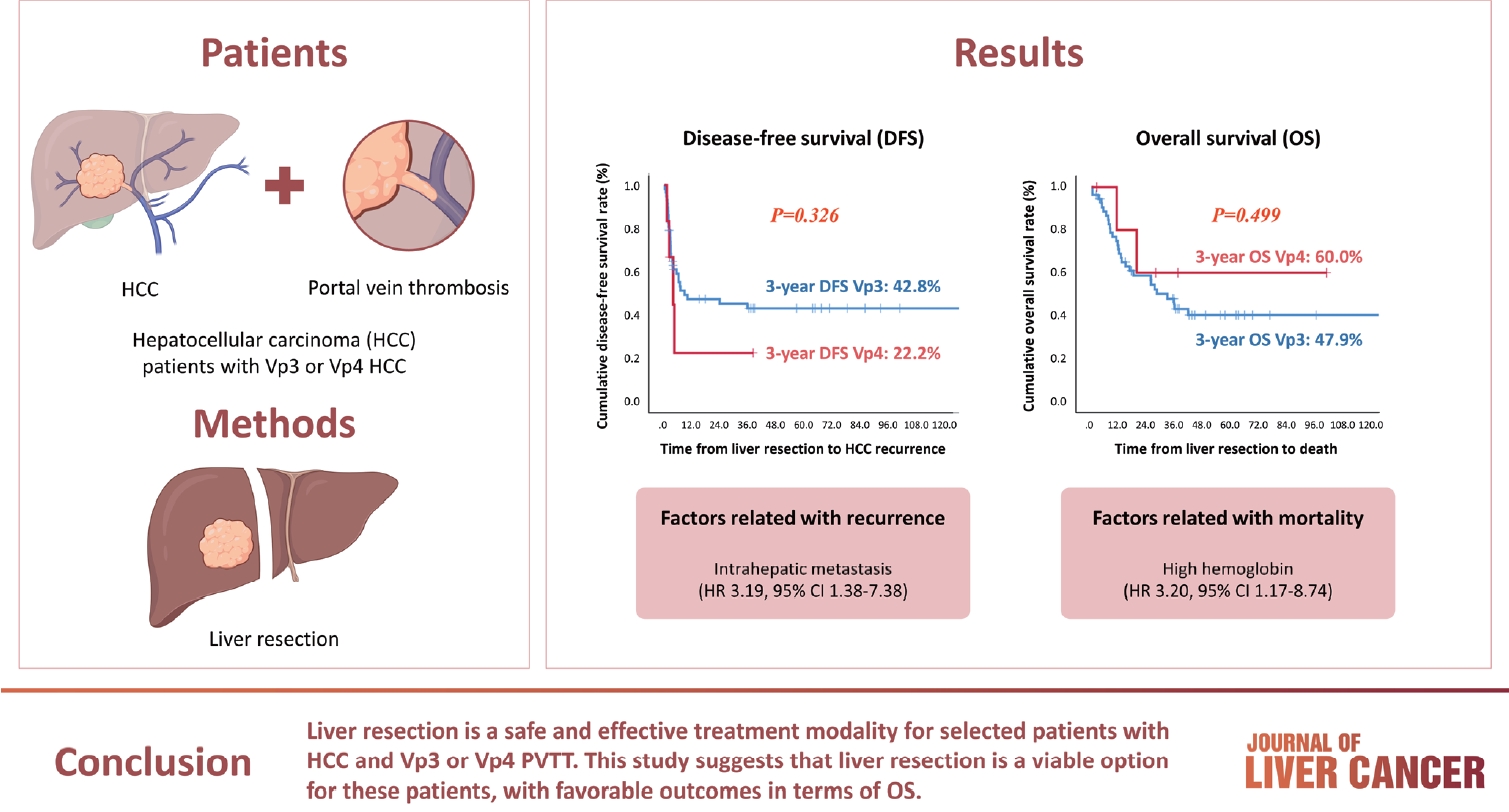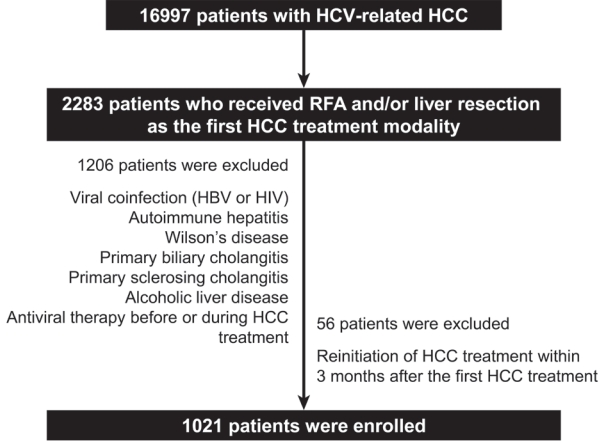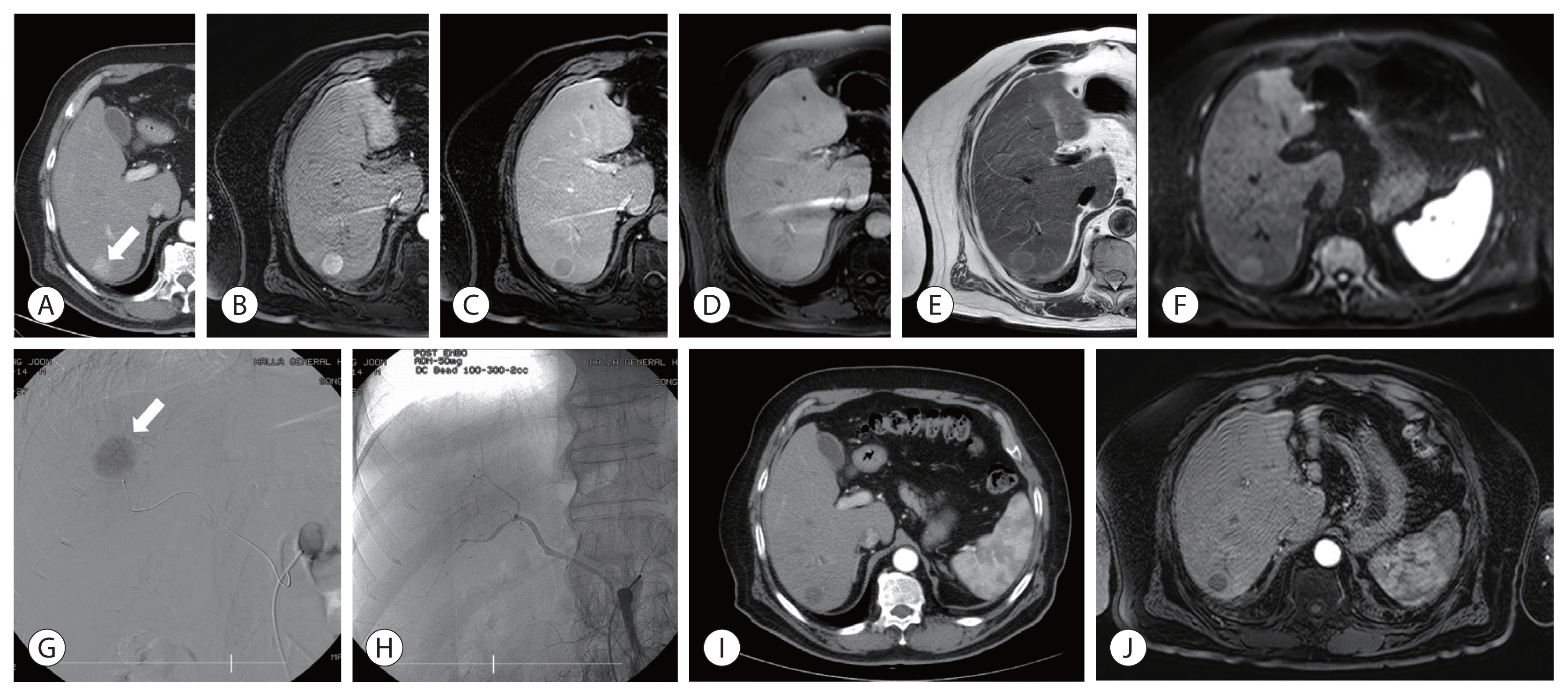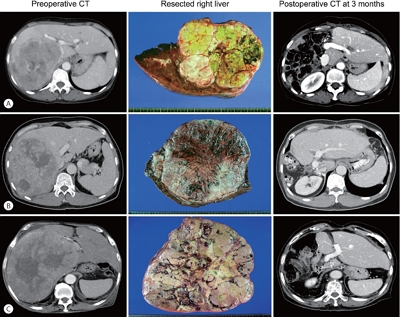Search
- Page Path
- HOME > Search
Original Articles
- Liver resection in selective hepatocellular carcinoma with Vp3 or Vp4 portal vein tumor thrombosis improves prognosis
- Manuel Lim, Jongman Kim, Jinsoo Rhu, Gyu-Seong Choi, Jae-Won Joh
- J Liver Cancer. 2024;24(1):102-112. Published online February 14, 2024
- DOI: https://doi.org/10.17998/jlc.2024.01.31

- 401 Views
- 38 Downloads
-
 Abstract
Abstract
 PDF
PDF - Background/Aim
Hepatocellular carcinoma (HCC) tumor thrombi located in the first branch of the portal vein (Vp3) or in the main portal trunk (Vp4) are associated with poor prognosis. This study aimed to investigate the clinicopathological characteristics and risk factors for HCC recurrence and mortality following liver resection (LR) in patients with Vp3 or Vp4 HCC.
Methods
The study included 64 patients who underwent LR for HCC with Vp3 or Vp4 portal vein tumor thrombosis (PVTT).
Results
Fifty-eight patients (90.6%) had Vp3 PVTT, whereas the remaining six patients exhibited Vp4 PVTT. The median tumor size measured 8 cm, with approximately 36% of patients presented with multiple tumors. Fifty-four patients (84.4%) underwent open LR, whereas 10 patients underwent laparoscopic LR. In the Vp4 cases, combined LR and tumor thrombectomy were performed. The 3-year cumulative disease-free survival rate was 42.8% for the Vp3 group and 22.2% for the Vp4 group. The overall survival (OS) rate at 3 years was 47.9% for the Vp3 group and 60.0% for the Vp4 group. Intrahepatic metastasis has been identified as an important contributor to HCC recurrence. High hemoglobin levels are associated with high mortality.
Conclusion
LR is a safe and effective treatment modality for selected patients with Vp3 or Vp4 HCC PVTT. This suggests that LR is a viable option for these patients, with favorable outcomes in terms of OS.

- Effect of direct-acting antivirals for hepatitis C virus-related hepatocellular carcinoma recurrence and death after curative treatment
- Young-Hwan Ahn, Heirim Lee, Ji Eun Han, Hyo Jung Cho, Jae Youn Cheong, Bumhee Park, Soon Sun Kim
- J Liver Cancer. 2022;22(2):125-135. Published online June 28, 2022
- DOI: https://doi.org/10.17998/jlc.2022.05.24

- 2,965 Views
- 78 Downloads
- 4 Citations
-
 Abstract
Abstract
 PDF
PDF Supplementary Material
Supplementary Material - Background/Aim
There has been a long-standing debate about the association of directacting antiviral (DAA) therapy and hepatocellular carcinoma (HCC) recurrence. This study aimed to investigate the association between DAA therapy and HCC recurrence after curative therapy.
Methods
We retrospectively enrolled 1,021 patients with HCV-related (hepatitis C virus) HCC who underwent radiofrequency ablation (RFA), liver resection, or both as the first treatment modality from January 2007 to December 2016 and without a history of HCV therapy before HCC treatment from a nationwide database. The effect of HCV treatment on HCC recurrence and all-cause mortality was also investigated.
Results
Among the 1,021 patients, 77 (7.5%) were treated with DAA, 14 (1.4%) were treated with interferon-based therapy, and 930 (91.1%) did not receive HCV therapy. DAA therapy was an independent prognostic factor for lower HCC recurrence rate (hazard ratio [HR], 0.04; 95% confidence interval [CI], 0.006-0.289; P=0.001 for landmarks at 6 months after HCC treatment and HR, 0.05; 95% CI, 0.007-0.354; P=0.003 for landmarks at 1 year). Furthermore, DAA therapy was associated with lower all-cause mortality (HR, 0.049; 95% CI, 0.007-0.349; P=0.003 for landmarks at 6 months and HR, 0.063; 95% CI, 0.009-0.451; P=0.006 for landmarks at 1 year).
Conclusions
DAA therapy after curative HCC treatment can decrease HCC recurrence and all-cause mortality compared to interferon-based therapy or no antiviral therapy. Therefore, clinicians should consider administering DAA therapy after curative HCC treatment in patients with HCV-related HCC. -
Citations
Citations to this article as recorded by- Comparison of Surgical Resection and Radiofrequency Ablation in Elderly Patients with Hepatocellular Carcinoma
Jun Il Kim, Jayoun Lee, Gi Hong Choi, Min Woo Lee, Dong Ah Park, Jeong-Ju Yoo
Digestive Diseases and Sciences.2024; 69(3): 1055. CrossRef - Analyzing risk factors and developing a stratification system for hepatocellular carcinoma recurrence after interferon-free direct-acting antiviral therapy in chronic hepatitis C patients
Chih-Hsuan Luan, Pin-Shuo Su, Chi-Jen Chu, Chung-Chi Lin, Chien-Wei Su, Jiing-Chyuan Luo, I-Cheng Lee, Chen-Ta Chi, Shou-Dong Lee, Yuan-Jen Wang, Fa-Yauh Lee, Yi-Hsiang Huang, Ming-Chih Hou
Journal of the Chinese Medical Association.2024; 87(4): 357. CrossRef - Addition of Kidney Dysfunction Type to MELD-Na for the Prediction of Survival in Cirrhotic Patients Awaiting Liver Transplantation in Comparison with MELD 3.0 with Albumin
Kyeong-Min Yeom, Jong-In Chang, Jeong-Ju Yoo, Ji Eun Moon, Dong Hyun Sinn, Young Seok Kim, Sang Gyune Kim
Diagnostics.2023; 14(1): 39. CrossRef - Is direct-acting antiviral treatment beneficial or harmful for patients with hepatitis C virus-related hepatocellular carcinoma?
Hye Won Lee
Journal of Liver Cancer.2022; 22(2): 91. CrossRef
- Comparison of Surgical Resection and Radiofrequency Ablation in Elderly Patients with Hepatocellular Carcinoma

- Transarterial chemoembolization using drug-eluting bead compared with radiofrequency ablation for treatment of single small hepatocellular carcinoma: a pilot non-randomized trial
- Tae Hoon Kim, Na Hye Kim, Jin Dong Kim, Young Nam Kim, Yu Jin Kim, Eun Jung Kim, Ki Deok Yoo, Choong Heon Ryu, Ha Hun Song, Hyun Kim
- J Liver Cancer. 2021;21(2):146-154. Published online August 11, 2021
- DOI: https://doi.org/10.17998/jlc.2021.05.20

- 4,254 Views
- 135 Downloads
- 3 Citations
-
 Abstract
Abstract
 PDF
PDF Supplementary Material
Supplementary Material - Background/Aim
s: Surgical resection, transplantation, and radiofrequency ablation (RFA) are generally accepted as amenable treatments for small hepatocellular carcinoma (HCC). Recently drug-eluting beads (DEB) which had several treatment advantages were introduced for transarterial chemoembolization (TACE). The aim of this study was to evaluate feasibility and safety of DEB-TACE compared with RFA for the treatment of single small HCC.
Methods
In this pilot non-randomized trial, we assessed retrospective data of 40 patients who underwent DEB-TACE (n=21) or RFA (n=19) for single small (≤3 centimeter in greatest dimension) HCC. The primary outcomes were tumor response and time to recurrence. The secondary outcome was treatment-related complications.
Results
Complete response rate to DEB-TACE and RFA after first follow-up assessment was 90.5% and 94.7%, respectively (P=1.000). During mean follow-up of 87.6 months (95% confidence interval: 74.4-102), 7 patients experienced local recurrence. The 6- and 12-month cumulative local recurrence rate was 5.0% and 21.8% in DEB-TACE vs. 11.1% and 17.0% in RFA group (P=0.877). A total 14 distant intrahepatic recurrences were developed and 12- and 24-month cumulative distant intrahepatic recurrence rate was 20.6% and 42.7% in DEBTACE vs. 17.2% and 36.3% in RFA group (P=0.844). Two patients experienced gangrenous cholecystitis after DEB-TACE requiring cholecystectomy as treatment-related adverse event.
Conclusions
Tumor response and recurrence rate after single session of DEB-TACE or RFA were similar. DEB-TACE could be applied selectively in patients with a single small HCC if the other therapeutic modality is unfeasible. -
Citations
Citations to this article as recorded by- Incidence and Risk Factors of Acute Ischemic Cholecystitis after Transarterial Chemoembolization: Correlation with Cone Beam CT Findings
Jong Yeong Kim, Jung Suk Oh, Ho Jong Chun, Su Ho Kim
Journal of the Korean Society of Radiology.2024;[Epub] CrossRef - Drug-Eluting Bead Transarterial Chemoembolization Versus Radiofrequency Ablation as an Initial Treatment of Single Small (≤ 3 cm) Hepatocellular Carcinoma
Somin Lee, Yong Yeon Jeong, Byung Chan Lee, Sang Soo Shin, Suk Hee Heo, Hyoung Ook Kim, Chan Park, Won Gi Jeong
Journal of Korean Medical Science.2023;[Epub] CrossRef - Comparable Outcomes in Early Hepatocellular Carcinomas Treated with Trans-Arterial Chemoembolization and Radiofrequency Ablation
Benjamin Wei Rong Tay, Daniel Q. Huang, Muthiah Mark, Neo Wee Thong, Lee Guan Huei, Lim Seng Gee, Low How Cheng, Lee Yin Mei, Prem Thurairajah, Lim Jia Chen, Cheng Han Ng, Wen Hui Lim, Darren Jun Hao Tan, Da Costa Maureen, Kow Wei Chieh Alfred, Iyer Shrid
Biomedicines.2022; 10(10): 2361. CrossRef
- Incidence and Risk Factors of Acute Ischemic Cholecystitis after Transarterial Chemoembolization: Correlation with Cone Beam CT Findings

- Prediction of Post-resection Prognosis Using the ADV Score for Huge Hepatocellular Carcinomas ≥13 cm
- Shin Hwang, Ki-Hun Kim, Deok-Bog Moon, Chul-Soo Ahn, Tae-Yong Ha, Gi-Won Song, Dong-Hwan Jung, Gil-Chun Park
- J Liver Cancer. 2021;21(1):45-57. Published online March 31, 2021
- DOI: https://doi.org/10.17998/jlc.21.1.45

- 4,184 Views
- 75 Downloads
- 1 Citation
-
 Abstract
Abstract
 PDF
PDF - Background/Aim
s: Multiplication of α-fetoprotein, des-γ-carboxy prothrombin, and tumor volume (ADV score) is a surrogate marker for post-resection prognosis of hepatocellular carcinoma (HCC). This study aimed to validate the predictive power of the ADV score-based prognostic prediction model for patients with solitary huge HCC.
Methods
Of 3,018 patients, 100 patients who underwent hepatic resection for solitary HCC ≥13 cm between 2008 and 2012 were selected.
Results
The median tumor diameter and tumor volume were 15.0 cm and 886 mL, respectively. Tumor recurrence and overall survival (OS) rates were 70.7% and 66.0% at one year and 84.9% and 34.0% at five years, respectively. Microvascular invasion (MVI) was the only independent risk factor for disease-free survival (DFS) and OS. DFS and OS, stratified by ADV score with 1-log intervals, showed significant prognostic contrasts (P=0.007 and P=0.017, respectively). DFS and OS, stratified by ADV score with a cut-off of 8-log, showed significant prognostic contrasts (P=0.014 and P=0.042, respectively). The combination of MVI and ADV score with a cut-off of 8-log also showed significant prognostic contrasts in DFS (P<0.001) and OS (P=0.001) considering the number of risk factors. Prognostic contrast was enhanced after combining the MVI and ADV score.
Conclusions
The prognostic prediction model with the ADV score could reliably predict the risk of tumor recurrence and long-term patient survival outcomes in patients with solitary huge HCCs ≥13 cm. The results of this study suggest that our prognostic prediction models can be used to guide surgical treatment and post-resection follow-up for patients with huge HCCs. -
Citations
Citations to this article as recorded by- ADV score is a reliable surrogate biomarker of hepatocellular carcinoma in liver resection and transplantation
Shin Hwang, Dong-Hwan Jung, Gi-Won Song
Annals of Liver Transplantation.2023; 3(2): 86. CrossRef
- ADV score is a reliable surrogate biomarker of hepatocellular carcinoma in liver resection and transplantation

Case Reports
- Complete Remission with Transarterial Chemoembolization in a Patient with Hepatocellular Carcinoma Who Showed Early Recurrence following Surgical Resection
- Kim, Hee Yeon , Kim, Chang Wook , Kim, Sungkeun , Lee, Soo Lim , Ku, Young Mi , Won, Yoo Dong
- J Liver Cancer. 2018;18(2):162-167. Published online September 30, 2018
- DOI: https://doi.org/10.17998/jlc.18.2.162
- 1,668 Views
- 25 Downloads
-
 Abstract
Abstract
 PDF
PDF - Although surgical resection is a curative treatment option for solitary hepatocellular carcinoma, high recurrence rate contributes to dismal long-term prognosis after curative resection. Early recurrence within 2 years after surgery is associated with intrahepatic metastasis of primary tumor. Liver regeneration after hepatic resection can accelerate tumorigenesis in remnant liver. Treatment strategies for intrahepatic recurrence after curative resection include salvage transplantation, repeated resection, local ablation, and transarterial chemoembolization (TACE). Here, we report a 51-year-old male who was presented with a single large tumor located at segment 4. The patient was initially treated with surgical resection, but intrahepatic recurrence occurred only 4 months after surgery. He achieved complete remission with repeated TACE and has survived without recurrence for 4 years so far.

- A Case of Rapidly Recurred Hepatocellular Carcinoma with Distant Metastasis after Surgical Resection
- Mi Yeon Kim, Hye Won Lee, Kyu Sik Jung, Beom Kyung Kim, Seung Up Kim, Jun Yong Park, Sang Hoon Ahn, Kwang-Hyub Han, Do Young Kim
- J Liver Cancer. 2015;15(2):136-139. Published online September 30, 2015
- DOI: https://doi.org/10.17998/jlc.15.2.139
- 885 Views
- 7 Downloads
-
 Abstract
Abstract
 PDF
PDF - Hepatocellular carcinoma (HCC) is one of the cancers with poor prognosis. However, surgical resection is the treatment of choice as curative aim for early HCC with preserved liver function. A 5 year survival rate after curative resection is over 50%. We experienced a case of rapidly recurred HCC with bone metastasis after surgical resection. In our case, microscopically microvessel invasion was present after resection. Microvascular invasion (MVI) is an important factor to influence survival and/or HCC recurrence. So we suggested the patients with MVI need to follow up intensively and adjuvant therapy may be considered.

- A Case of Long Term Survival in Patient with Early Intrahepatic Recurrence and Extrahepatic Metastasis after Curative Resection of Hepatocellular Carcinoma
- Dong Il Jeong, Young Mi Hong, Mong Cho, Ki Tae Yoon
- J Liver Cancer. 2015;15(2):132-135. Published online September 30, 2015
- DOI: https://doi.org/10.17998/jlc.15.2.132
- 979 Views
- 10 Downloads
-
 Abstract
Abstract
 PDF
PDF - The most effective therapy in patients with hepatocellular carcinoma (HCC) is curative resection of liver cancer. However, the long-term prognosis is not good in high intrahepatic recurrence. The recurrence rate after curative resection of HCC is 70-100% and the average survival time was about 15.8 months in early relapse after curative resection. Extra hepatic metastases in HCC is associated not uncommon, in general, lungs are the most common organ, lymph nodes, bone, and adrenal gland is relatively often observed. Extrahepatic recurrence after curative resection of HCC has been reported in 14-26% of the total recurrent cancer. Most of the recurrent cancer is multiple and the median survival time of patients after the extrahepatic recurrence is about 4-5 months it found that the prognosis is very poor. Therefore, the authors report a case showed long term survival in patients with early intrahepatic recur and extrahepatic metastasis after curative resection of HCC.

- Two Cases of Early Recurred Hepatocellular Carcinoma after Surgical Resection Which Showed Different Outcomes
- Young Youn Cho, Jeong-Hoon Lee, Nam Joon Yi, Kwang Woong Lee, Kyung Suk Suh, Yoon Joon Kim, Jung-Hwna Yoon
- J Liver Cancer. 2015;15(2):126-131. Published online September 30, 2015
- DOI: https://doi.org/10.17998/jlc.15.2.126
- 783 Views
- 6 Downloads
-
 Abstract
Abstract
 PDF
PDF - Hepatocellular carcinoma (HCC) has poor prognosis, even after curative resection. Early
recurrence after curative treatment is a major cause of the poor prognosis. Pathologic factors
such as vessel invasion, satellite nodule, size of tumor and pathologic grade are prognostic
factors predicting early recurrence and poor prognosis. We share our experience of two
case
s which both showed early recurrence after curative hepatic resection, but eventually demonstrated different prognosis. Since the most common cause of death after potentially curative treatment is tumor recurrence, suppression of tumor recurrence might be linked to survival gain. Currently, there is no adjuvant therapy for HCC endorsed by international guidelines. However, recent studies have shown that antiviral treatment for hepatitis B virusrelated HCC and immunotherapy using autologous cytokine-induced killer cell reduced HCC recurrence. Further study is needed to select patients who will benefit from adjuvant treatments.

- A Case of Management for Early Recurrence after Hepatic Resection for the Treatment of Small Hepatocellular Carcinoma
- Kyung Woo Park, Young Seok Kim, Sang Gyune Kim, Soung Won Jeong, Jae Young Jang, Hong Soo Kim, Sae Hwan Lee, Boo Sung Kim, Jun Cheol Jeong, Min Hee Lee, Jae Myeong Lee, Hee Kyung Kim
- J Liver Cancer. 2015;15(2):122-125. Published online September 30, 2015
- DOI: https://doi.org/10.17998/jlc.15.2.122
- 1,056 Views
- 6 Downloads
-
 Abstract
Abstract
 PDF
PDF - For a small hepatocellular carcinoma (HCC), liver resection shows most favorable outcome in
case
which liver transplantation is not available, although it has also substantial recurrence rate. Here, we report a case of recurred HCC with multiple intrahepatic metastasis at 5 months after surgical resection for small HCC was done. A 55-year-old man with chronic HBV infection received subsegmentectomy for HCC less than 2 cm. A follow-up computed tomography (CT) at 5 months from operation revealed that there were multiple enhancing nodules in entire remnant liver. Intra-arterial injections of adriamycin mixed lipiodol and gelfoam particles were instituted through hepatic artery. We assume that poorly differentiated cellular feature would be attributable to this kind of very early and aggressive recurrence of HCC. (J Liver Cancer 2015;15:122-125)

- A Case of Early Multiply Recurred Hepatocellular Carcinoma after Surgical Resection in Patient Who Unprecedented Chronic Liver Disease
- Wang Yong Choi, Byoung Kuk Jang, Woo Jin Chung, Jae Seok Hwang
- J Liver Cancer. 2015;15(2):112-117. Published online September 30, 2015
- DOI: https://doi.org/10.17998/jlc.15.2.112
- 869 Views
- 4 Downloads
-
 Abstract
Abstract
 PDF
PDF - Hepatocellular carcinoma (HCC) have relatively well known causative factors such as chronic hepatitis B, chronic hepatitis C, alcoholic liver disease, Non-alcoholic fatty liver disease (NAFLD), liver cirrhosis and so on. Recently, interesting reports that HCC in the absence of cirrhosis or other chronic liver disease and HCC associated with NAFLD and metabolic syndrome are increasing in USA. So far, there is no report about these issues in Korea. We present a 65 yearold obesity male who had no preceding chronic liver disease history. He was diagnosed as primary HCC and the mass was removed completely. However, HCC recurred shortly after operation. Multiple recurred HCC were treated with transcatheter arterial chemoembolization. (J Liver Cancer 2015;15:112-117)

- A Case of Hepatocellular Carcinoma Recurred Extensively during Treatment of Biliary Complication Occurring after Transarterial Chemoembolization
- Hyun Jung Oh, Hana Park, Kwang Hoon Lee, Do Young Kim, Sang Hoon Ahn, Kwang-Hyub Han, Chae Yoon Chon, Jun Yong Park
- Journal of the Korean Liver Cancer Study Group. 2011;11(2):178-184. Published online September 30, 2011
- 518 Views
- 3 Downloads
-
 Abstract
Abstract
 PDF
PDF - Hepatocellular carcinoma(HCC) is one of the cancers with poor prognosis. Transarterial chemoembolization(TACE) has been widely used for treating unresectable HCC. Although TACE is considered as a less invasive and relative safe procedure, severe complications such as hepatic failure, pulmonary embolism, liver abscess, biloma formationcan occur rarely after TACE. These complications sometimes may lead to fatal clinical situation, even death. We reported a case of HCC recurred extensively during treatment of biliary complication after TACE. A 44-year-old male with HCC was admitted due to fever for 3 days after undergoing TACE. Three weeks before the admission, he had been diagnosed with HCC recurrence which presented as two arterial enhancing nodules in MRI and treated with TACE. CT scan showed 7 cm sized air containing fluid collections with necrosis suggestive of liver abscess and 15 cm sized biloma formation. Because the patient was in septic shock at admission, percutaneous catheter drainage was performed with use of broad spectrum antibiotics. After treatment of 3 months, the sizes of hepatic abscess and biloma were remarkably decreased. However, 1 month later, large size tumor recurrence and perihepatic lymph node metastasis were found on a follow-up CT scan. In this case, the cause of rapid growing recurrence after TACE is uncertain, but the development of unanticipated complication seems to affect the progression to poor prognosis. Therefore, early recognization of predisposing factors with proper management would be needed to prevent these serious complications after TACE.

- A Case of Hepatocellular Carcinoma with Early Multiple Recurrences after Liver Resection
- Jae Hong Ahn, Hyung Joon Yim, Seung Young Kim, Jeong Han Kim, Yeon Seok Seo, Seung Hwa Lee, Hwan Hoon Chung, Tae Jin Song, Hong Sik Lee, Sang Woo Lee, Soon Ho Um, Jai Hyun Choi, Ho Sang Ryu
- Journal of the Korean Liver Cancer Study Group. 2009;9(1):29-32. Published online June 30, 2009
- 523 Views
- 3 Downloads
-
 Abstract
Abstract
 PDF
PDF - Hepatic resection is a standard curative therapy for hepatocellular carcinoma (HCC) although only 10~30% of patients are indicated due to advanced stage or poor hepatic reserve. Five year survival rate after resection was reported as a mean of 55% (25~93%), but cases of early recurrence after hepatic resection had poor prognosis. As early recurrence after hepatic resection is the one of the most important factors that determines the prognosis, many investigators have been trying to determine the factors associated with early recurrence. We report a case of early multiple recurrence of HCC after curative hepatic resection probably due to microvascular invasion of tumor and too close resection margin. We would like to suggest that additional prophylactic measures need to be sought in this group of patients because these factors may influence on early recurrence.

- A Case of Hepatocellular Carcinoma Presenting Early Intrahepatic Recurrence Following Hepatic Resection
- Jaejun Shim, Byung-Ho Kim, Young Hwangbo, Sang Wook Lee, Young Ju Lee, Seung Hyung Ha, Jae Young Jang, Seok Ho Dong, Hyo Jong Kim, Young Woon Chang, Rin Chang, Sang Mok Lee
- Journal of the Korean Liver Cancer Study Group. 2009;9(1):33-36. Published online June 30, 2009
- 504 Views
- 0 Download
-
 Abstract
Abstract
 PDF
PDF - Long term results of hepatic resection for hepatocellular carcinoma (HCC) are not satisfactory due to a high incidence of postoperative recurrence. To improve the prognosis in patients who underwent hepatic resection, identification of risk factors for recurrence and development of effective preventive strategies are required. A single nodular mass was found in the right hepatic lobe of 53-year old male with B viral cirrhosis by surveillance ultrasonography. Dynamic abdominal CT showed a 3 cm-sized hypervascular mass in the right posteroinferior segment (S6). AFP was 359 ng/mL. Child-Pugh classification was A, and ICG R15 was 18.8%. After preoperative transarterial chemoembolization (TACE), right hepatic wedge resection was performed. Resection margin was free of tumor. Microinvasions in the surrounding vessels, lymphatics, bile ducts were not found and microsatellite nodules were absent in the resected specimen. Although there were no risk factors that associated with high postoperative recurrence, multifocal intrahepatic recurrence in the right lobe and left medial lobe occurred at 7 months after hepatic resection. He underwent two sessions of TACE.

- Early Intrahepatic Recurrence of Hepatocellular Carcinoma with Metastasis to Lung and Brain after Radiofrequency Ablation
- Jin Dong Kim, Jung Hyun Kwon, Si Hyun Bae, Jong Young Choi, Seung Kew Yoon, Young Jun Lee, Sung Eun Rha, Ho Jong Chun, Byung Gil Choi, Hae Giu Lee
- Journal of the Korean Liver Cancer Study Group. 2009;9(1):37-40. Published online June 30, 2009
- 543 Views
- 2 Downloads
-
 Abstract
Abstract
 PDF
PDF - Radiofrequency ablation (RFA) is the preferred method of local ablation for patients with small (<3 cm sized) hepatocellular carcinoma (HCC) when surgical resection cannot be applied. If RFA procedure is sufficiently completed, it provides lower local tumor recurrence, and longer overall as well as disease-free survival. We experienced a case of early stage HCC which recurred at 2 months after successful RFA procedure, and rapidly metastasized to lung and brain.

- A Case of Early Recurred Hepatocellular Carcinoma with Initial Expectation of Good outcome by Surgical Resection
- Jung Min Lee, Jun Yong Park, Do Young Kim, Kyung Sik Kim, Young Nyun Park, Myeong-Jin Kim, Chae Yoon Chon, Kwang-Hyub Han
- Journal of the Korean Liver Cancer Study Group. 2009;9(1):41-44. Published online June 30, 2009
- 536 Views
- 2 Downloads
-
 Abstract
Abstract
 PDF
PDF - Hepatocellular carcinoma (HCC) is one of the cancers with poor prognosis as HCC develops on base of cirrhosis in majority cases, which requires multidisciplinary approach. If feasible, however, surgical resection is the choice of treatment, and many previous studies and guidelines offered appropriate indications for surgical resection; firstly, preservation of liver function should be confirmed with traditional Child-Pugh classification or more recently with Indocyanine Green retention test or absence of portal hypertension. Secondly, several variables about the size, number, and vascular invasion of tumor should be taken into consideration. It is suggested that to lessen the risk of recurrence gross vascular invasion be absent and the number of tumor be single. Regarding the size of tumor, although risk of dissemination increases with size, some tumors may grow as a single mass and thus the size of tumor is not a clear-cut limiting factor. Based on above suggestions, we herein offer our experience of a patient with initial hopeful expectation of good outcome with surgical resection, but who eventually turned out to result in disseminated tumor recurrence. Further study, maybe regarding a combination of adjuvant or neoadjuvant transarterial chemoembolization/chemotherapy or radiotherapy, is necessary on how to manage such patient.


 E-submission
E-submission THE KOREAN LIVER CANCER ASSOCIATION
THE KOREAN LIVER CANCER ASSOCIATION

 First
First Prev
Prev



 Follow JLC on Twitter
Follow JLC on Twitter